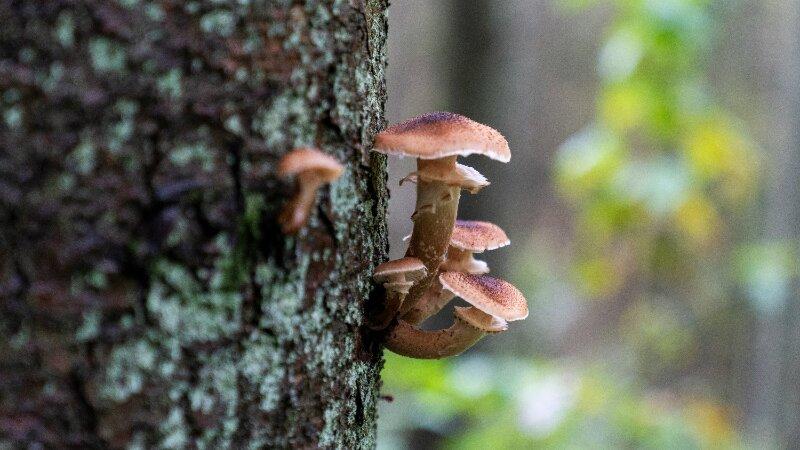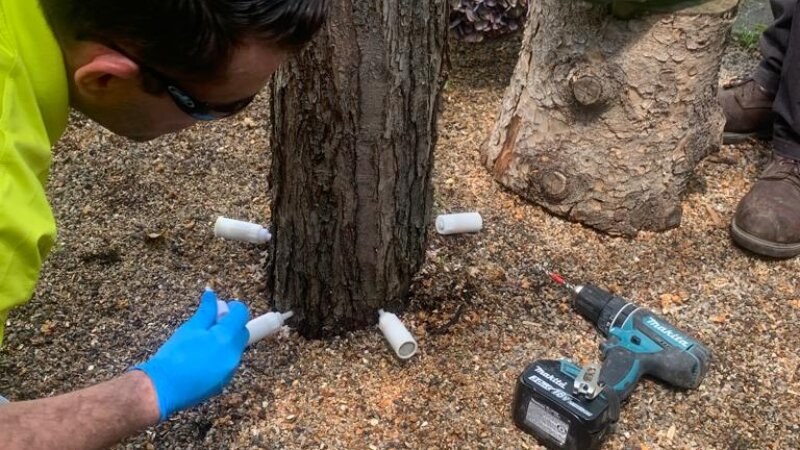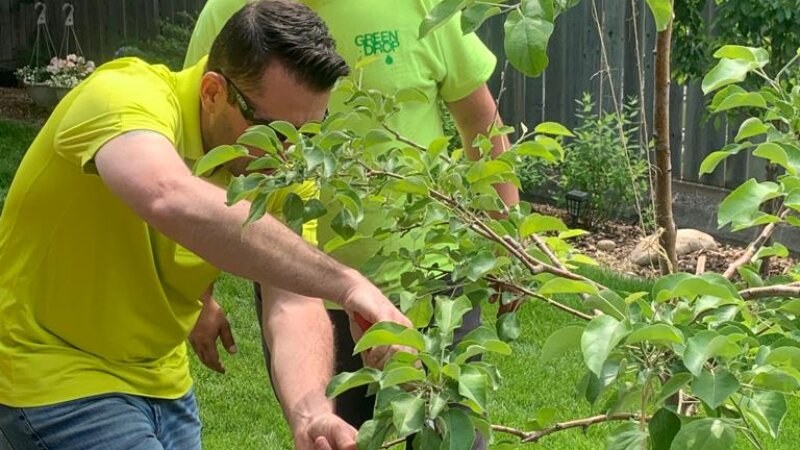How to Spot Signs of Tree Decay and Disease and Act On Time
Reading time: 8 minutesIt's easy to tell if a tree is healthy. They stand tall and firm, with thick foliage and vibrant green leaves. But how do you know if a tree is diseased or decaying, and why is it important? Below, learn about different tree diseases, what signs to look for to tell if your tree is decaying, and what you can do about it.

Common Tree Diseases in Western Canada
Unfortunately, trees in Canada are at risk of numerous problems when not well cared for. If you’ve ever seen a tree with mushrooms on it, you’ve seen a diseased tree, probably without even realizing it.
Tree diseases can be caused by bacteria, harmful fungi, and unwanted pests that carry these pathogens. Some of the most common tree diseases include things like:
- Black knot fungus. Black knot fungus is mostly seen on ornamental and edible plum tree varieties, producing a thick, round "gall" that grows like a tumour from the wood.
- Bronze leaf disease. According to the City of Calgary, bronze leaf disease is a specific type of fungus that primarily impacts certain kinds of poplar and aspen trees. Infected portions of the tree may exhibit orange or reddish-brown leaf discoloration that starts on the outer edges of the leaves and travels inward to the stem and branch. Usually, the symptoms of this condition are seen in the fall and may not be very noticeable at first.
- Dutch elm disease. Dutch elm disease (DED) is a serious tree infection that can quickly cause death in many species of elm trees. Like many tree diseases, DED is also caused by a fungus. It can either spread from tree to tree via root grafts or by elm bark beetles that eat the wood and transmit the pathogen. When identified early enough, DED can be treated with fungicides and pruning away the diseased portions of the tree. It's important to note that effective treatment is largely dependent on early detection, typically within the first year of infection, which can be challenging due to subtle symptoms like wilting of leaves in the crown.
- Fire blight. The Government of British Columbia defines fire blight as a bacterial infection of pear and apple trees. This destructive condition can also affect related species of trees, like ash and hawthorn. Symptoms of fire blight include shrivelled, brown leaves and flowers that look almost as if they have been burned. Fire blight treatment includes pruning out infected branches well below the visibly diseased portion of the tree with clean, sanitized tools.
Types of Tree Decay
Tree decay occurs when the tree's internal structure has been attacked by one or more of the pathogens listed above. As bacteria and fungi move through the tree's vascular system, it destroys the wood inside. Diseased wood that can no longer support the tree's weight causes it to become weak and more susceptible to breaking or falling.
Here are some of the most common types of tree decay and their indicators:
- Soft Rot. Soft rot in trees can be caused by fungal, bacterial, or concurrent fungal and bacterial infections, which works in tandem to quickly break down the tree's cellulose, resulting in extensive damage to the core structure of the tree.
- White Rot. White rot is a condition that affects specifically the lignin of a tree, which is the substance that makes the wood hard and protects it from breakage. As the lignin rots away, only the light-coloured cellulose is left behind. This is soft, spongy, and easily peeled away from the tree.
- Brown Rot. Brown rot predominantly affects coniferous trees in Canada and is essentially the opposite of white rot. While white rot affects the tree's lignin and leaves cellulose behind, brown rot affects the tree's cellulose and leaves the lignin behind. What's left is hard and crumbly, like an overbaked cookie.
- Sap Rot. Sap rot is a fungal infection that generally develops in the tree's crown on dead branches. Conditions like these are, in part, why removing dead or diseased branches from trees is crucial as soon as you notice them.
- Heart Rot. While heart rot can affect any type of tree, it's most common in hardwoods and is caused by a fungal disease that produces mushrooms on the surface of the tree. This condition occurs when the fungus reaches the inside of the tree or its heartwood and causes the tree to rot from the inside out.

Top Signs a Tree Is Decaying or Diseased
It may not always be obvious that a tree has become diseased or is starting to decay. Knowing how to identify these common issues can help you detect problems quickly so they can be addressed before they kill the tree or spread to nearby trees.
These are some of the most important signs to look for when determining if a tree is diseased or healthy:
Peeling Bark
A tree's bark is what protects the heartwood from external threats. When you notice this is peeling, crumbling, or breaking off, it's a good sign the tree has become compromised, and there's trouble brewing beneath the surface.
Leaf Discoloration
Healthy trees have bright, green leaves that are full and lush throughout the branches. Any colour changes that aren't congruent with falling leaves in autumn could indicate decay or disease. Look specifically for browning or yellowing at the edges of the leaves or unusual-looking spots across the leaf. Leaf discoloration in strange patterns is usually a clear distress call from the tree.
The Tree Leans to One Side
A tree that starts to lean to one side or the other is likely suffering from damage to its heartwood or root rot. In both cases, it's unlikely the tree can be saved and may need to be removed before whatever has infected it moves on to the next tree beside it.
There Are Visible Wounds on the Tree
In most cases, bacterial and fungal infections start when these pathogens can reach the inside of the tree. If you see visible openings or wounds on the surface of the tree, there's a good chance that destructive microscopic organisms have already found their way in.
Improper cutting is one of the most common causes of tree deterioration, and it's crucial to ensure that tools are sanitized before use and in between each tree. Storm damage can also cause wounds that allow bacteria and fungi to enter.
Branches That Are Brittle or Break Easily
Healthy tree branches are flexible and can move around with ease. They're resilient to storms and animals, bending instead of breaking when weight is applied. Branches that are brittle or break easily indicate decay, most likely brown rot.
It's a good idea to regularly inspect your tree branches for signs of breakage since this is one of the early signs of disease before pathogens reach the tree trunk or heartwood.
Dieback
Dieback is a term that refers to the gradual death or slow decline of a tree. This usually starts at the tips of the branches and moves inward, almost as if a poisonous fog were encroaching on the tree. This condition can happen for several reasons, including bacteria, fungi, pests, and environmental stressors. If you catch dieback early enough, you can save the tree.

What to Do If Your Tree Is Dying
It can sometimes be difficult to tell whether a tree is dying or already dead. Even though both tend to look brown, dry, and lacklustre, intervening may be possible if the tree hasn't completely died yet.
Here are some things you can do to help resurrect a dying tree:
- Adjust your watering schedule. If your tree is dying because it's drying out, this can easily be remedied by getting on the proper watering schedule. Adult trees generally need about 10 gallons of water a week for every inch of trunk diameter.
- Mulch around your tree. This can help reintroduce nutrients to the soil around your tree if fertilization has been the problem. Ensure you're not using dyed mulch or too much around the base.
- Wait to prune. Pruning an unhealthy tree will only worsen the problem. Wait to prune until your tree is healthier and has regained some of its natural resilience.
As always, the phrase rings true: “An ounce of prevention is worth a pound of cure” when caring for your trees. Preventing problems rather than correcting them is easier, so ensure you employ good tree care practices year-round.
Tree Care Experts You Can Turn To
Green Drop’s tree specialists and ISA-certified arborists understand the complex nature of trees and how to take care of them so they stay healthy. We provide comprehensive tree care service in western Canada and throughout Alberta and British Columbia.
If you’re in Winnipeg, you can use our state-of-the-art tree disease diagnostic lab to analyze your trees’ health. From there, our arborists help you develop a custom treatment plan.
Our team is dedicated to helping you discover and implement best practices so you can keep your yards looking great and contribute to critical environmental initiatives that combat climate change.

